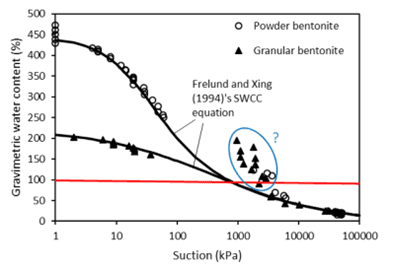Is a GCL with granular bentonite really better than one with powder?
Manufacturers of geosynthetic clay liners (GCL) produce different products where the gradation of the bentonite inside the GCL ranges from powder to coarse granular bentonite. It is not uncommon to hear different point of views or claims that certain types of bentonite are better for water retention than the others in certain applications. Solmax uses both powder and granular bentonites it's GCL products, so which one is better?
To find out which is better we conducted a literature study to gain with some preliminary insight into the debate.
There are studied1,2 functionality differences between different GCL products related to the type and amount of bentonite, GCL structure and manufacturing method. And it is not only the GCL but even subsoil characteristics and temperature conditions that can have effects on how well GCL behaves.
Tong et al.1 have studied retention characteristics of granular and powder bentonites and have come to following conclusions. Both powder and granular bentonites show similar water retention curves (WRC) when suctions exceed 1,000 kPa. However, the water content of powdered bentonite is much higher than granular bentonite at suctions less than 1,000 kPa. The higher water content of powder bentonite implies that it has excessive swelling and shrinking behaviour and has a higher permeability than granular bentonite at comparable suction at suctions less than 1,000 kPa. These characteristics are undesirable as a barrier in a landfill containment system for example.

The higher water content of powder bentonite can be explained by its higher free swelling compared to granular bentonite. However, the free swelling cannot explain quantitatively the saturated gravimetric water contents of powder and granular bentonites.
Barckay et al.2 have studied temperature effects on GCL hydration made either from powder or granular bentonite. From their study one could conclude that subsoil characteristics have a bigger influence on GCL hydration – and thus performance – than if bentonite was in powder or granular format. With higher temperatures, both types of bentonites lose some of their ability to hydrate, which leads higher diffusion and permeability values in both cases. In their study, powder bentonite performed slightly better when compared to their maximum hydration levels in all temperatures. In this case, powder bentonite GCL was manufactured with a scrim reinforced carrier layer compared to normal woven geotextile carrier layer used with the granular bentonite. This might have influenced the results since there have been other studies showing that good needle punching and additional nonwoven features positively affect the water retention curves, and thus the performance of the GCL.
After this literature review, it seems that there is still no clear answer if powder or granular bentonite is better. It seems that there is only partial understanding of the nature of a GCL. There are several other things contributing the GCL’s effectiveness as a barrier.
Thus, would there be truly a difference with functionality between different GCLs if they would be manufactured similarly but using bentonite powder or granular bentonite was the only difference and everything else remained constant? This topic will be in our next blog where we presented this question to Professor Kerry Rowe, who is one of the most recognized pioneers in the Geosynthetics industry.
Catrin Tarnowski, Senior Technical Manager at Solmax, [email protected]
Co-author: Perttu Juntunen, Solmax Technical Sales Manager - Nordics & Baltics, [email protected]
1 W.Y. Tong i), M. Wijaya ii) and E.C. Leong iii), Water retention characteristics of granular and powder bentonites, Article in Japanese Geotechnical Society Special Publication · April 2019
2 Arden Barclay and Mohammad T Rayhani, Effect of temperature on hydration of geosynthetic clay liners in landfills.
Explore more blogs
View allDo geosynthetic clay liners require prehydration?
How geosynthetics enhance agricultural productivity in arid regions
How GEOTUBE dewatering technology helped to restore a river’s ecology
The demolition of dams on La Sélune River in Normandy, France, and the use GEOTUBE dewatering containers restored ecology and biodiversity in the river.